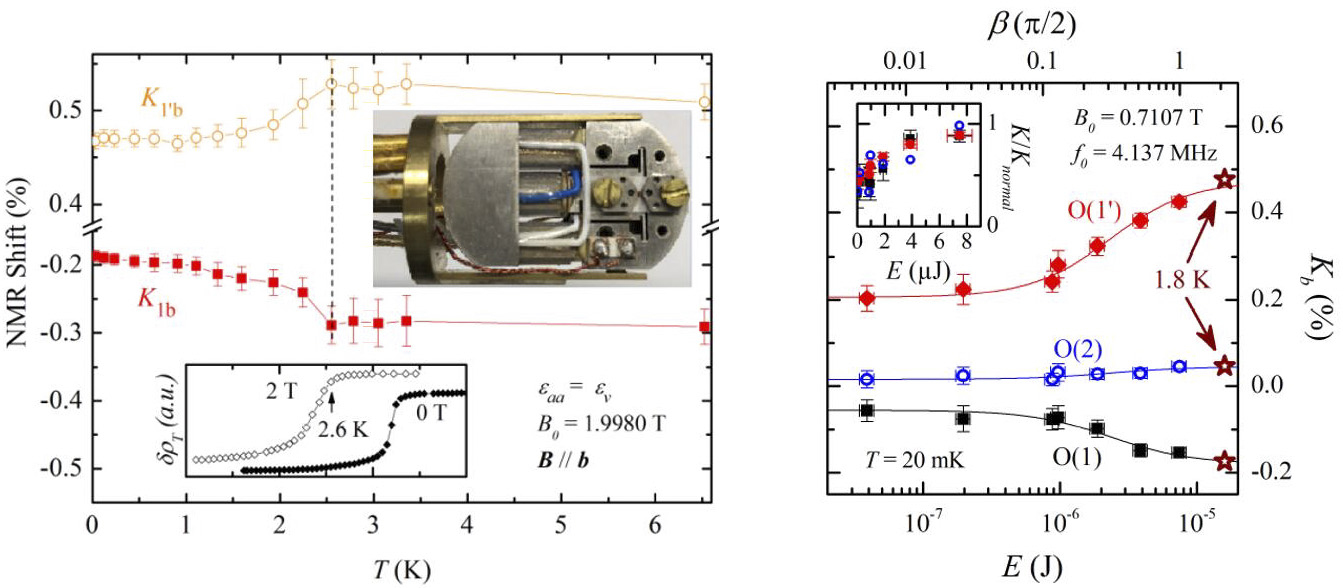
Left: Temperature dependence of 17O Knight shift in Sr2RuO4 for strain at vHs. The upper inset shows the apparatus to apply strain. The low inset shows the superconducting transition at vHs for B=0 and 2 T.
Right: 17O Knight shift of Sr2RuO4 at ambient, plotted as a function of RF pulse input.
(Nature 2019, DOI: https://doi.org/10.1038/s41586-019-1596-2)
Background
Phase of matter is characterized by symmetry and order parameter, and this is particularly true for unconventional superconductivity. However, in some cases, determining the symmetry and order parameter is notoriously difficult, for e.g. Sr2RuO4. This compound is deemed as one of the most fascinating unconventional superconductors ever since its discovery in 1994. Although it shares the same crystalline structure with single-layer high-Tc cuprates, its Tc value is much lower than that of the high-Tc. At the early stage of its discovery, theorists predicted ap-wave pairing state in Sr2RuO4. The experimental evidence for p-wave pairing came primarily from the "unchanged" spin susceptibility and simultaneously time reversal symmetry breaking, the combination of which point to a p-wave order parameter with chiral feature,d=z(kx±iky). However, controversies on its precise pairing symmetry have persisted. For example, the absence of Tc vs. strain cusp near zero strain in the uniaxial strain measurements on Sr2RuO4 appears to suggest that a simplep-wave on a single-band is not likely.
What we discover?
In this work, we systematically investigated the superconducting state of Sr2RuO4 by 17O NMR measurements, in the presence of uniaxial stress. The important findings are: By quantifying and controlling the intensity of radio-frequency (RF) pulse, we found pronounced changes in the Knight shift of 17O upon the superconducting transition. This placed strong constraints on the order parameter of Sr2RuO4, because all the possibilities of p-wave order parameters with d parallel with z should be skeptical, especially the well-known chiral p-wave case. However, we are reluctant to declare that all the p-wave scenarios are impossible. It is the amount of the change in the Knight shift that tells, for which purpose, more careful measurements are required in the future.
Why is this important?
This work is important for the reasons below. First, understanding unconventional superconductivity itself is one of the hot spots in the fields of condensed matter physics. Superconductivity with peculiar pairing symmetry and order parameter is particularly interesting. However, realistic examples of such are scare. For decades, Sr2RuO4 has been suggested as a rare paradigm of spin-triplet superconductor with chiral properties, which is considered as a candidate of topological superconductor that may host Majorana zero mode and is of applicable potential in future quantum computation. Our careful 17O NMR measurements manifested that this probably is skeptical, for which people have to reconsider seriously about the pairing symmetry of this unconventional superconductor. This work likely will boost up more theoretical and experimental studies in the field in the near future.
Who did the research?
A. Pustogow1,8*, Yongkang Luo1,2,8*,A. Chronister1, Y.-S. Su1, D. A. Sokolov3, F. Jerzembeck3, A. P. Mackenzie3,4, C. W. Hicks3, N. Kikugawa5, S. Raghu6, E. D. Bauer7& S. E. Brown1*
1Department of Physics and Astronomy, University of California Los Angeles, Los Angeles, CA, USA.
2Wuhan National High Magnetic Field Center and School of Physics, Huazhong University of Science and Technology, Wuhan, China.
3Max Planck Institute for Chemical Physics of Solids, Dresden, Germany.
4School of Physics and Astronomy, University of St Andrews, St Andrews, UK.
5National Institute for Materials Science, Tsukuba, Japan.
6Geballe Laboratory for Advanced Materials, Stanford University, Stanford, CA, USA.
7Los Alamos National Laboratory, Los Alamos, New Mexico, USA.
8These authors contributed equally: A. Pustogow, Yongkang Luo.
*e-mail: pustogow@physics.ucla.edu; mpzslyk@gmail.com; brown@physics.ucla.edu
Acknowledgements
We thank M. Ikeda and S. Kivelson for conversations. We particularly appreciate discussions with K. Ishida and Y. Maeno about the implications of our findings, and K. Ishida for reproducing our results. A.P. acknowledges support by the Alexander von Humboldt Foundation through a Feodor Lynen Fellowship. Y.L. acknowledges support by the 1000 Youth Talents Plan of China. N.K. acknowledges support from JSPS KAKENHI (number JP18K04715) and JST-Mirai Program (number JPMJMI18A3) in Japan. S.R. is supported in part by the US Department of Energy, Office of Basic Energy Sciences, contract DEAC02-76SF00515. This work was supported in part by the National Science Foundation (DMR-1709304) and by the Laboratory Directed Research and Development (LDRD) programme of Los Alamos National Laboratory under project number 20170204ER.
https://www.nature.com/articles/s41586-019-1596-2
